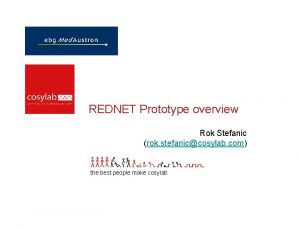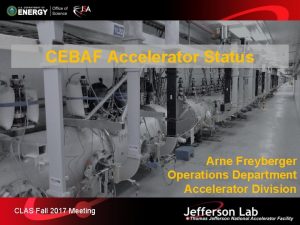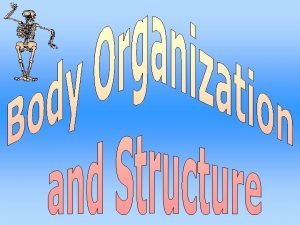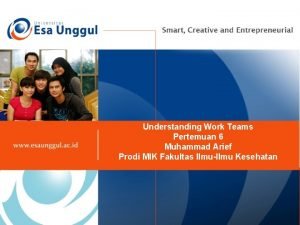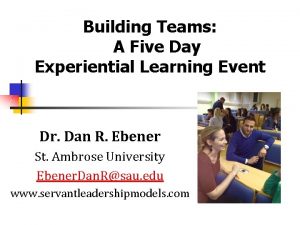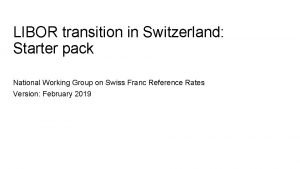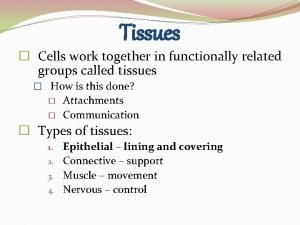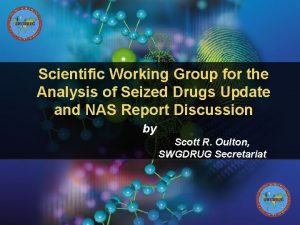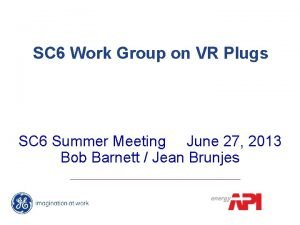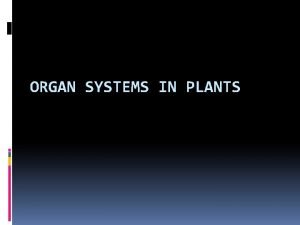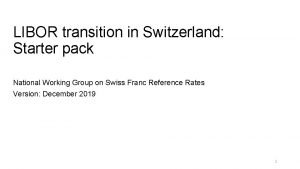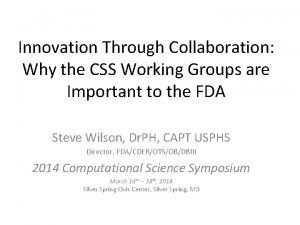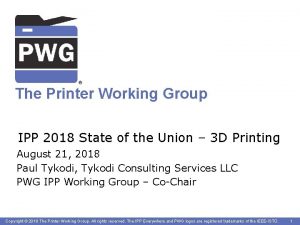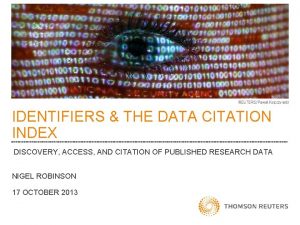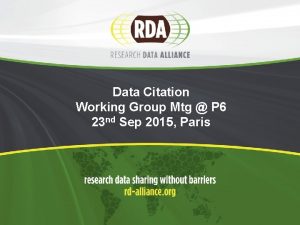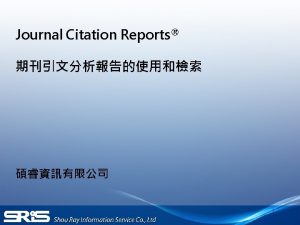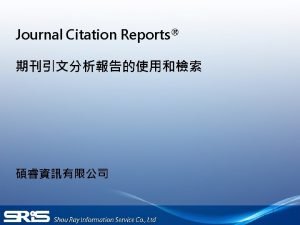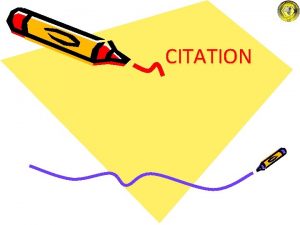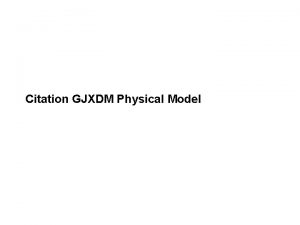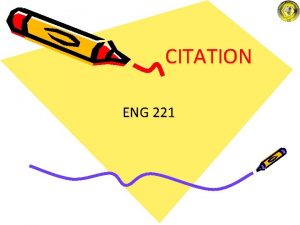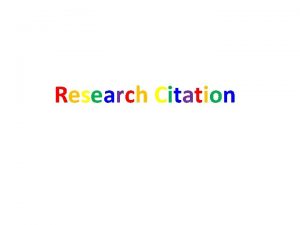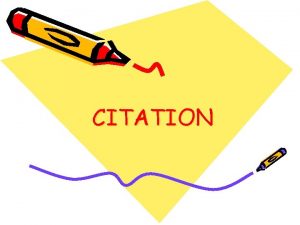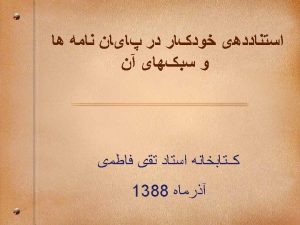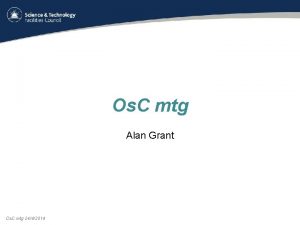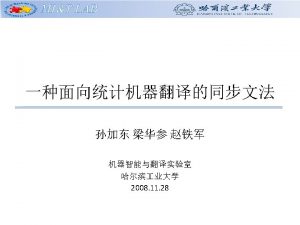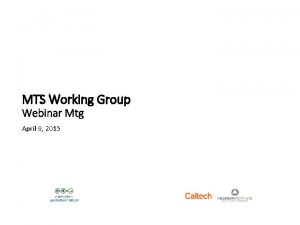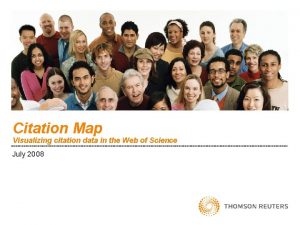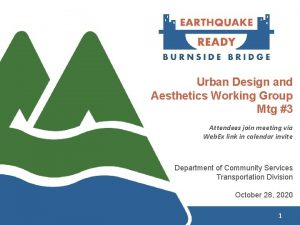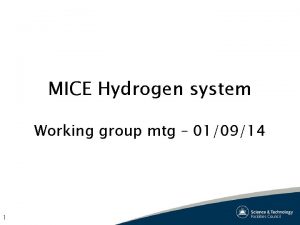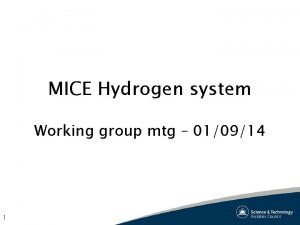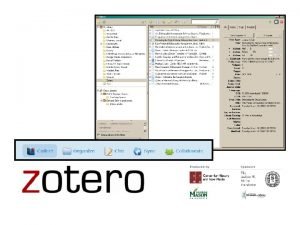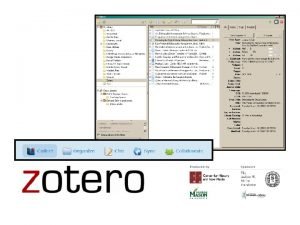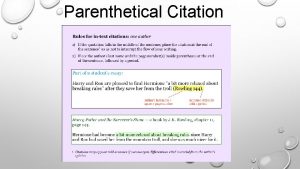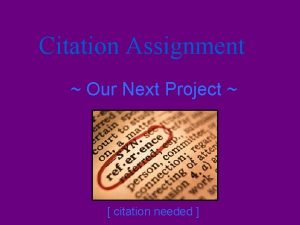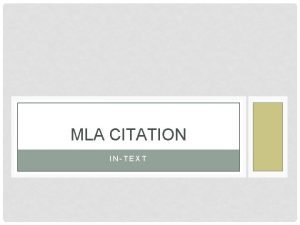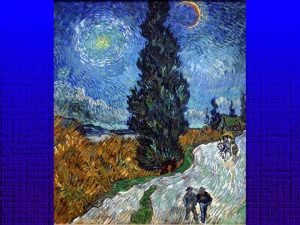Data Citation Working Group Mtg P 15 April

































- Slides: 33

Data Citation Working Group Mtg @ P 15 April 8 2020, virtually (Melbourne)

Agenda § § § Introduction, Welcome Short description of the WG recommendations Q&A on recommendations Reports by adopters / pilots Paper on adoption stories Other issues, next steps 2

Welcome and Intro Welcome! to the maintenance meeting of the WGDC 3

Agenda § § § Introduction, Welcome Short description of the WG recommendations Q&A on recommendations Reports by adopters / pilots Paper on adoption stories Other issues, next steps 4

Identification of Dynamic Data § Usually, datasets have to be static § Fixed set of data, no changes: no corrections to errors, no new data being added § But: (research) data is dynamic § Adding new data, correcting errors, enhancing data quality, … § Changes sometimes highly dynamic, at irregular intervals § Current approaches § Identifying entire data stream, without any versioning § Using “accessed at” date § “Artificial” versioning by identifying batches of data (e. g. annual), aggregating changes into releases (time-delayed!) § Would like to identify precisely the data as it existed at a specific point in time 5

Granularity of Subsets § What about the granularity of data to be identified? § Enormous amounts of CSV data § Researchers use specific subsets of data § Need to identify precisely the subset used § Current approaches § Storing a copy of subset as used in study -> scalability § Citing entire dataset, providing textual description of subset -> imprecise (ambiguity) § Storing list of record identifiers in subset -> scalability, not for arbitrary subsets (e. g. when not entire record selected) § Would like to be able to identify precisely the subset of (dynamic) data used in a process 6

RDA WG Data Citation § Research Data Alliance § WG on Data Citation: Making Dynamic Data Citeable § March 2014 – September 2015 § Concentrating on the problems of large, dynamic (changing) datasets § Final version presented Sep 2015 at P 7 in Paris, France § Endorsed September 2016 at P 8 in Denver, CO § Since: support for take-up/adoption, lessons-learned https: //www. rd-alliance. org/groups/data-citation-wg. html 7

Dynamic Data Citation We have: Data + Means-of-access (“query”) 8

Dynamic Data Citation We have: Data + Means-of-access (“query”) Dynamic Data Citation: Cite (dynamic) data dynamically via query! § 9

Dynamic Data Citation We have: Data + Means-of-access (“query”) Dynamic Data Citation: Cite (dynamic) data dynamically via query! § Steps: 1. Data versioned (history, with time-stamps) 10

Dynamic Data Citation We have: Data + Means-of-access (“query”) Dynamic Data Citation: Cite (dynamic) data dynamically via query! § Steps: 1. Data versioned (history, with time-stamps) Researcher creates working-set via some interface: 11

Dynamic Data Citation 12 We have: Data + Means-of-access (“query”) Dynamic Data Citation: Cite (dynamic) data dynamically via query! § Steps: 1. Data versioned (history, with time-stamps) Researcher creates working-set via some interface: 2. Access store & assign PID to “QUERY”, enhanced with - Time-stamping for re-execution against versioned DB - Re-writing for normalization, unique-sort, mapping to history - Hashing result-set: verifying identity/correctness leading to landing page

Data Citation – Deployment § Researcher uses workbench to identify subset of data § Upon executing selection („download“) user gets - Data (package, access API, …) PID (e. g. DOI) (Query is time-stamped and stored) Hash value computed over the data for local storage Recommended citation text (e. g. Bib. Te. X) § PID resolves to landing page - Provides detailed metadata, link to parent data set, subset, … - Option to retrieve original data OR current version OR changes § Upon activating PID associated with a data citation - Query is re-executed against time-stamped and versioned DB - Results as above are returned § Query store aggregates data usage 13

Data Citation – Deployment Note: queryuses stringworkbench provides excellent § Researcher to identify subset of data provenance information the data set! § Upon executing selectionon („download“) user gets - Data (package, access API, …) PID (e. g. DOI) (Query is time-stamped and stored) Hash value computed over the data for local storage Recommended citation text (e. g. Bib. Te. X) § PID resolves to landing page - Provides detailed metadata, link to parent data set, subset, … - Option to retrieve original data OR current version OR changes § Upon activating PID associated with a data citation - Query is re-executed against time-stamped and versioned DB - Results as above are returned § Query store aggregates data usage 14

Data Citation – Deployment Note: queryuses stringworkbench provides excellent § Researcher to identify subset of data provenance information the data set! § Upon executing selectionon („download“) user gets - Data (package, API, …) advantage over This access is an important PID (e. g. DOI) (Query is time-stamped and stored) traditional approaches relying on, e. g. Hash value computed over the data for local storage storing a list of identifiers/DB dump!!! Recommended citation text (e. g. Bib. Te. X) § PID resolves to landing page - Provides detailed metadata, link to parent data set, subset, … - Option to retrieve original data OR current version OR changes § Upon activating PID associated with a data citation - Query is re-executed against time-stamped and versioned DB - Results as above are returned § Query store aggregates data usage 15

Data Citation – Deployment Note: queryuses stringworkbench provides excellent § Researcher to identify subset of data provenance information the data set! § Upon executing selectionon („download“) user gets - Data (package, API, …) advantage over This access is an important PID (e. g. DOI) (Query is time-stamped and stored) traditional approaches relying on, e. g. Hash value computed over the data for local storage storing a list of identifiers/DB dump!!! Recommended citation text (e. g. Bib. Te. X) § PID resolves to. Identify landingwhich pageparts of the data are used. - Provides detailed metadata, link toidentify parent data set, queries subset, … If data changes, which - Option to retrieve originalare dataaffected OR current version OR changes (studies) § Upon activating PID associated with a data citation - Query is re-executed against time-stamped and versioned DB - Results as above are returned § Query store aggregates data usage 16

Data Citation – Recommendations Preparing Data & Query Store - R 1 – Data Versioning - R 2 – Timestamping - R 3 – Query Store When Data should be persisted - R 4 – Query Uniqueness R 5 – Stable Sorting R 6 – Result Set Verification R 7 – Query Timestamping R 8 – Query PID R 9 – Store Query R 10 – Citation Text 17 When Resolving a PID - R 11 – Landing Page - R 12 – Machine Actionability Upon Modifications to the Data Infrastructure - R 13 – Technology Migration - R 14 – Migration Verification

Data Citation – Output § 14 Recommendations grouped into 4 phases: § 2 -page flyer https: //rd-alliance. org/recommendations-workinggroup-data-citation-revision-oct-20 -2015. html § More detailed report: Bulletin of IEEE TCDL 2016 http: //www. ieee-tcdl. org/Bulletin/v 12 n 1/papers/IEEETCDL-DC-2016_paper_1. pdf § Adopter’s presentations, webinars and reports https: //www. rd-alliance. org/group/data-citationwg/webconference-data-citationwg. html 18

WGDC Webinar Series 19 § https: //www. rd-alliance. org/group/data-citation-wg/ webconference/webconference-data-citation-wg. html § Implementation of the RDA Data Citation Recommendations by the Earth Observation Data Center (EODC) for the open. EO platform Wed, Nov 20 2019, 17: 00 CET § Automatically generating citation text from queries for RDBMS and XML data sources § Implementing of the RDA Data Citation Recommendations by the Climate Change Centre Austria (CCCA) for a repository of Net. CDF files § Implementing the RDA Data Citation Recommendations for Long-Tail Research Data / CSV files § Implementing the RDA Data Citation Recommendations in the Distributed Infrastructure of the Virtual and Atomic Molecular Data Center (VAMDC) § Implementation of Dynamic Data Citation at the Vermont Monitoring Cooperative § Adoption of the RDA Data Citation of Evolving Data Recommendation to Electronic Health Records

RDA Recommendations - Summary § Benefits § Allows identifying, retrieving and citing the precise data subset with minimal storage overhead by only storing the versioned data and the queries used for extracting it § Allows retrieving the data both as it existed at a given point in time as well as the current view on it, by re-executing the same query with the stored or current timestamp § It allows to cite even an empty set! § The query stored for identifying data subsets provides valuable provenance data § Query store collects information on data usage, offering a basis for data management decisions § Metadata such as checksums support the verification of the correctness and authenticity of data sets retrieved § The same principles work for all types of data 20

Agenda § § § Introduction, Welcome Short description of the WG recommendations Q&A on recommendations Reports by adopters / pilots Paper on adoption stories Other issues, next steps 21

Large Number of Adoptions 22 § Standards / Reference Guidelines / Specifications: § Joint Declaration of Data Citation Principles: Principle 7: Specificity and Verifiability (https: //www. force 11. org/datacitation) § ESIP: Data Citation Guidelines for Earth Science Data Vers. 2 (P 14) § ISO 690, Information and documentation - Guidelines for bibliographic references and citations to information resources (P 13) § EC ICT TS 5 Technical Specification (pending) (P 12) § Data. Cite Considerations (P 8) § Reference Implementations § § My. SQL/Postgres (P 5, P 6) CSV files: My. SQL, Git (P 5, P 6, P 8, Webinar) XML (P 5) CKAN Data Repository (P 13)

Large Number of Adoptions § Pilot implementations, Use cases § § § DEXHELPP: Social Security Records (P 6) NERC: ARGO Global Array (P 6) LNEC: River dam monitoring (P 5) CLARIN: Linguistic resources, XML (P 5) MSD: Million Song Database (P 5) many further individual ones discussed … 23

Large Number of Adoptions § Adoptions deployed § § § CBMI: Center for Biomedical Informatics, WUSTL (P 8, Webinar) VMC: Vermont Monitoring Cooperative (P 8, Webinar) CCCA: Climate Change Center Austria (P 10/P 11/P 12, Webinar) EODC: Earth Observation Data Center (P 14, Webinar) VAMDC: Virtual Atomic and Molecular Data Center (P 8/P 10/P 12, Webinar) § In progress § § NICT Smart Data Platform (P 10/P 14) Dendro System (P 13) Ocean Networks Canada (P 12) Deep Carbon Observatory (P 12) 24

RDA WGDC Recommendations in ESIP Guidelines Mark Parsons

Designing Dynamic Data Citation for Data Provenance on Smart Data Platform Koji Zettsu, Yasuhiro Murayama National Institute of Information and Communications Technology Japan

Climate Change Center Austria Chris Schubert

Others? Plans, On-going, Feedback Anybody

Adoption Stories 29 § Let us know if you are (planning to) implement (part of) the recommendations § Submit your adoption story to the RDA Webpage: https: //www. rd-alliance. org/recommendationsoutputs/adoption-stories

Agenda § § § Introduction, Welcome Short description of the WG recommendations Q&A on recommendations Reports by adopters / pilots Paper on adoption stories Other issues, next steps 30

WGDC Paper § Paper summarizing adoptions & lessons learned § 1 Section per adoption with description of § § § data center, data & data dynamics solution architecture versioning / timestamping approach query store set-up lessons learned, issues identified § Finalizing paper § Other forms of summary? 31

Next steps 32 § Finalizing paper § Which other forms of experience sharing would be helpful?

Thanks 33 Thanks! And hope to see you at the next meeting of the WGDC
 How to calculate yield maintenance prepayment in excel
How to calculate yield maintenance prepayment in excel Wheel of misfortune
Wheel of misfortune Mtg
Mtg Mtg rok
Mtg rok Mtg arne
Mtg arne Smart work vs hard work
Smart work vs hard work Hot principle
Hot principle Hot working and cold working difference
Hot working and cold working difference Machining operations
Machining operations Pembentukan logam
Pembentukan logam Crisis communications working group
Crisis communications working group Oecd working group on bribery
Oecd working group on bribery Similar cells that work together
Similar cells that work together Understanding work teams
Understanding work teams Coloured gemstones working group
Coloured gemstones working group A group vs a team
A group vs a team Asean working group on environmentally sustainable cities
Asean working group on environmentally sustainable cities Awgcc
Awgcc National working group on swiss franc reference rates
National working group on swiss franc reference rates Power curve performance management
Power curve performance management Group of cells working together
Group of cells working together Scientific working group for the analysis of seized drugs
Scientific working group for the analysis of seized drugs Plug working group
Plug working group Power curve working group
Power curve working group A group of organs working together
A group of organs working together Switzerland starter pack
Switzerland starter pack Css working group
Css working group Industrial security working group
Industrial security working group Working group on international cooperation
Working group on international cooperation Printer working group
Printer working group Ashwg
Ashwg Data citation index
Data citation index Two factor theory psychology
Two factor theory psychology Within group variance vs between group
Within group variance vs between group



